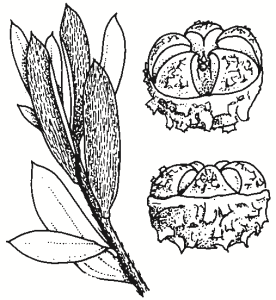Family:
Myrtaceae
Leptospermum grandifolium
Mountain Tea-tree
Other Names: Woolly Tea-tree

Name Origin:
Leptospermum — from Greek leptos, slender, and sperma, seed, referring to narrow seeds of some species.
grandifolium — from Latin grandis, large and folium, foliage, referring to large leaves.
Regional Subspecies:
Occurrence:
Regional:
Noted in the upper Murray areas: Rosewood Plateau; Paddy’s River- Burra Valley; Maragle; Tooma; Ardenside-Welaregang; Lower Tooma-Greg Greg and Bringenbrong-Khancoban.
Australia:
NSW, Vic, Tas.
Habitat:
Sandy swamps and rocky streambanks.
Habit:
Large, fairly dense shrub to small rounded tree 1.5 m to over 6 m high. Leaves mostly 1-3 cm long.
Site Preference:
Moist to wet soil such as seepages and streamsides. Tolerates moderate frost.
Characteristics:
Adaptable. Moderate to fast growth rate.
Flowering:
White, Oct-Jan.
Seed Collection:
Any time. Seeds retained for many years, and shed after adversity such as injury, drought or fire. Collect capsules from older wood. Seeds highly viable, remaining so for many years in storage.
Propagation:
From seed or cuttings, which strike readily. Sow light scattering of seed and cover lightly. Germinates in 2-5 weeks. Capillary watering should benefit fine seed. Suitable for direct seeding into pots.
Regeneration:
From seed.
VALUES:
Shade & Shelter:
Useful low-level cover in windbreaks.
Land Protection:
Useful in controlling streambank and gully erosion due to soil-binding fibrous roots.
Wildlife:
Excellent habitat. Prickly foliage excellent refuge for small birds, particularly dense thickets. Flowers are a good pollen and nectar source for many native insects, including moths and butterflies. Insect-eating birds attracted.
Timber:
Used for turning.
Ornamental:
Attractive. Prune to promote bushiness.
Other:
Used in colonial medicine.
